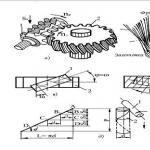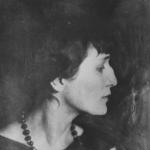Kuznetsov Konstantin Vasilievich (1886 -1943) - graphic artist. Attended classes at the Drawing School of the Society for the Encouragement of the Arts. In 1913 he made his debut as an illustrator in the magazine “New Satyricon”. Collaborated in the magazines “Apollo” and “Russian Icon”. He placed caricatures of artists in theater programs. During those same years, he became interested in folk art; he made sketches of handicraft toys (ladies, Cossacks, generals, horses), which, with the assistance of L.F. Ovsyannikov, he showed at exhibitions of the “Independent” partnership in Paris (1910-1913). In 1913 he lived in Moscow and Crimea, then moved to Pyatigorsk. He served at a telegraph station. He became close to the artist P. A. Alyakrinsky. After the October Revolution, he headed the glass printing department at Okna KavROST. In 1922 he moved to Moscow. In 1923 he took part in a polar expedition to the coast of the Arctic Ocean and to New Earth. In the first half of the 1930s, he headed the children's art circle in the Children's Book Propaganda Department of the Museum of Public Education of the RSFSR. He was engaged in easel, book, and magazine graphics. He worked in the techniques of woodcut printing, glass printing, lithography, linocut, monotype; developed a method of engraving with a dry point on cardboard with tinting with watercolors or pastels. As an illustrator, he collaborated in the magazines “Krasnaya Niva”, “Veselye Kartinki”, “Murzilka”. He designed books for the publishing houses “GIZ”, “Detgiz”, “Molodaya Gvardiya”, “Peasant Newspaper”, “Pravda”, “Soviet Writer” and others. He made illustrations for many books by Ya. P. Meksin: “The Mosquito-Mosquito” (1924), “The Cat-Cat” (1925), “Construction”, “How Papa Carried Tanya” (both 1926), “The Gray Duck” ( 1927), “Trouble,” “Whoever dared, ate it,” “Kartaus” (all - 1928), “Hold on, don’t lag behind” (1929), “Homemade products,” “Potatoes,” “Zinkin’s pictures” (all - 1930); A. L. Barto: Pioneers" (1926), "Toys", "Stars in the Forest" (both 1936), "Two Notebooks" (1941), "Flashlight" (1944). ~ Designed the books: "Mokhnach" V V. Bianchi (1927), “Filippok” by L. N. Tolstoy (1929), “Volodya Ermakov” by A. I. Vvedensky (1935), “The Nightingale” by G.-Kh. Andersen (1936), “Taman” by M. Yu. Lermontov (1937), “The Tale of the Golden Cockerel” (1937), “The Tale of Tsar Saltan” (1939), “Ruslan and Lyudmila” (1943) by A. S. Pushkin , “The Scarlet Flower” by S. T. Aksakov (1938), “The Tale of a Stupid Mouse” by S. Ya. Marshak (1938), “Sasha” by N. A. Nekrasov (1938), “Stories” (1938), “Lisichkin bread" (1941) by M. M. Prishvin, "The Fate of the Drummer" by A. P. Gaidar (1938, 1939), "Summer Days" (1937), "Tenants of the Old House" (1941) by G. K. Paustovsky, " Malachite Box"P.P. Bazhova (1944) and others. In total, he designed more than 200 books; many of them underwent numerous reprints both during the artist’s lifetime and after his death. ~Author of the series of easel lithographs “Dolls”, “Ivan the Tsarevich and the Gray Wolf”, “Ivan the Cow’s Son”, “O rejuvenating apples and living water”, “Sivka-burka”; anti-fascist engravings and drawings on the topic civil war in Spain, a series of drawings " Ancient Rus'"(1933), humorous series of drawings "Brem Inside Out" (1939-1940), "The Adventures of Babai" (1942-1943). He was involved in the design of the animated films “Aibolit” (1938), “The Tale of Tsar Saltan” (1939), “Kalotushka” (1940). ~Since 1910 - participant in exhibitions. Exhibited at the following exhibitions: 1st State Free Exhibition of Works of Art (1919), “Russian Woodcuts for 10 Years. 1917-1927" (1927) in Petrograd - Leningrad; the United Art group (OBIS, 1925), the Association of Graphic Artists (1926), Soviet color engraving (1937), the All-Union Exhibition of Children's Literature and Children's Book Illustration (1938) in Moscow; international exhibition “The Art of Books” in Leipzig (1927); Soviet graphics in Helsinki, Tallinn, Stockholm, Gothenburg (1934), London (1938), New York (1940) and others. The exhibition “New methods of hand printing in printing production”, which was organized by art historian A.V. Bakushinsky in the halls of the State Tretyakov Gallery (1933), was dedicated to Kuznetsov’s experimental methods of work in engraving (1933). ~A memorial exhibition of works was held in Moscow (1949). The monograph by M. Z. Kholodovskaya is dedicated to the artist’s work: “Konstantin Vasilyevich Kuznetsov” (M.-L., 1950; in the series “Masters of Soviet Art”). The works are in many museum collections, including the Pushkin Museum. A. S. Pushkin.
Kuznetsov Konstantin Vasilievich (1886 -1943) - graphic artist. Attended classes at the Drawing School of the Society for the Encouragement of the Arts. In 1913 he made his debut as an illustrator in the magazine “New Satyricon”. Collaborated in the magazines “Apollo” and “Russian Icon”. He placed caricatures of artists in theater programs. During those same years, he became interested in folk art; he made sketches of handicraft toys (ladies, Cossacks, generals, horses), which, with the assistance of L.F. Ovsyannikov, he showed at exhibitions of the “Independent” partnership in Paris (1910-1913). In 1913 he lived in Moscow and Crimea, then moved to Pyatigorsk. He served at a telegraph station. He became close to the artist P. A. Alyakrinsky. After the October Revolution, he headed the glass printing department at Okna KavROST. In 1922 he moved to Moscow. In 1923 he took part in a polar expedition to the coast of the Arctic Ocean and to Novaya Zemlya. In the first half of the 1930s, he headed the children's art circle in the Children's Book Propaganda Department of the Museum of Public Education of the RSFSR. He was engaged in easel, book, and magazine graphics. He worked in the techniques of woodcut printing, glass printing, lithography, linocut, monotype; developed a method of engraving with a dry point on cardboard with tinting with watercolors or pastels. As an illustrator, he collaborated in the magazines “Krasnaya Niva”, “Veselye Kartinki”, “Murzilka”. He designed books for the publishing houses “GIZ”, “Detgiz”, “Molodaya Gvardiya”, “Peasant Newspaper”, “Pravda”, “Soviet Writer” and others. He made illustrations for many books by Ya. P. Meksin: “The Mosquito” (1924), “The Cat-Cat” (1925), “Construction”, “How Papa Carried Tanya” (both 1926), “The Gray Duck” ( 1927), “Trouble,” “Whoever dared, ate it,” “Kartaus” (all - 1928), “Hold on, don’t lag behind” (1929), “Homemade products,” “Potatoes,” “Zinkin’s pictures” (all - 1930); A. L. Barto: Pioneers" (1926), "Toys", "Stars in the Forest" (both 1936), "Two Notebooks" (1941), "Flashlight" (1944). ~ Designed the books: "Mokhnach" V V. Bianchi (1927), “Filippok” by L. N. Tolstoy (1929), “Volodya Ermakov” by A. I. Vvedensky (1935), “The Nightingale” by G.-Kh. Andersen (1936), “Taman” by M. Yu. Lermontov (1937), “The Tale of the Golden Cockerel” (1937), “The Tale of Tsar Saltan” (1939), “Ruslan and Lyudmila” (1943) by A. S. Pushkin , “The Scarlet Flower” by S. T. Aksakov (1938), “The Tale of a Stupid Mouse” by S. Ya. Marshak (1938), “Sasha” by N. A. Nekrasov (1938), “Stories” (1938), “Lisichkin bread" (1941) by M. M. Prishvin, "The Fate of the Drummer" by A. P. Gaidar (1938, 1939), "Summer Days" (1937), "Tenants of the Old House" (1941) by G. K. Paustovsky, "Malachite box" P. P. Bazhova (1944) and others. In total, he designed more than 200 books; many of them underwent numerous reprints both during the artist’s lifetime and after his death. ~Author of the series of easel lithographs “Dolls”, “Ivan the Tsarevich and the Gray Wolf”, “Ivan the Cow’s Son”, “About Rejuvenating Apples and Living Water” , "Sivka-burka"; anti-fascist engravings and drawings on the theme of the Spanish Civil War, the series of drawings “Ancient Rus'” (1933), the humorous series of drawings “Break Inside Out” (1939-1940), “The Adventures of Babai” (1942-1943). He was involved in the design of animated films “Aibolit” (1938), “The Tale of Tsar Saltan” (1939), “Kalotushka” (1940). ~Since 1910 - participant in exhibitions. Exhibited at the following exhibitions: 1st State Free Exhibition of Works of Art (1919), “Russian Woodcuts for 10 Years. 1917-1927" (1927) in Petrograd - Leningrad; the United Art group (OBIS, 1925), the Association of Graphic Artists (1926), Soviet color engraving (1937), the All-Union Exhibition of Children's Literature and Children's Book Illustration (1938) in Moscow; international exhibition “The Art of Books” in Leipzig (1927); Soviet graphics in Helsinki, Tallinn, Stockholm, Gothenburg (1934), London (1938), New York (1940) and others. The exhibition “New methods of hand printing in printing production”, which was organized by art historian A.V. Bakushinsky in the halls of the State Tretyakov Gallery (1933), was dedicated to Kuznetsov’s experimental methods of work in engraving (1933). ~A memorial exhibition of works was held in Moscow (1949). The monograph by M. Z. Kholodovskaya is dedicated to the artist’s work: “Konstantin Vasilyevich Kuznetsov” (M.-L., 1950; in the series “Masters of Soviet Art”). The works are in many museum collections, including the Pushkin Museum. A. S. Pushkin.
Original taken from yzhka in Konstantin Kuznetso in
Today is the birthday of the illustrator Konstantin Vasilyevich Kuznetsov (1886-1943). A talented graphic artist, engraver, and draftsman, he did not receive any special art education. I studied engraving techniques on my own, took lessons from cousin, graphic artist L.F. Ovsyannikov, later worked mainly in the technique of engraving on cardboard that he invented. The first drawings were published in 1913 in the magazine “New Satyricon”. In the mid-1910s he left Petrograd for the Caucasus, collaborated in the Caucasian "Windows of GROWTH". From 1922 he lived in Moscow.  Worked at a children's book museum. He illustrated collections of fairy tales for Detgiz, and based on the illustrations he created easel lithographs published by the MTH printmaking workshop.
Worked at a children's book museum. He illustrated collections of fairy tales for Detgiz, and based on the illustrations he created easel lithographs published by the MTH printmaking workshop.
Konstantin Kuznetsov created his own unique and recognizable image of Russian children's books of the 20-40s. XX century. A special and main place in his work is occupied by illustrations of Russian folk tales. “Kolobok”, “Turnip”, “The Wolf and the Seven Little Goats”, “Ivan Tsarevich and the Gray Wolf”, “Teremok”, “Ivan the Cow’s Son”, “About Rejuvenating Apples and Living Water”, “Sivka-b” lesson" - here is just a small list of the huge list of Russian fairy tales. In total, the master illustrated about two hundred publications. Here is a bibliography of books with his illustrations. More than one generation of children in our country has grown up on them...
Unfortunately, I have almost no books with illustrations by Konstantin Kuznetsov. But surely someone will republish it))
I have quite a few of his books...
Volzhskaya pier. Illustration for a book. 1920s
Kuznetsov Konstantin Konstantinovich born April 16, 1895 in St. Petersburg (according to other sources, Voronezh) - Graphic artist, painter.
From the family of a teacher and a gymnasium teacher. Member of the First World War. In 1920, after his father was shot by the Bolsheviks (according to some sources, the murder was criminal in nature), he fled to the south of Russia, where he joined the Volunteer Army. At the end of 1920, he was evacuated along with its units from Crimea to the Kingdom of Serbs, Croats and Slovenes.
For some time he lived in the city of Pancevo near Belgrade; attended painting and drawing courses. He made posters for the Matic department store in Belgrade. He was engaged in book graphics, creating caricatures and posters.
He gained wide European fame as an author of comics: in 1937–1941 he created 26 comics for the Belgrade magazine “Mika Mis” (“Mickey Mouse”) by A. Ivkovic; among them are comics of the mystical-adventure genre: “Countess Margot”, “Vampire Baron (both 1939), “Three Lives” (1940), “The Mark of Death” (1941); based on Russian literature: “Hadji Murat” according to L. N. Tolstoy (1937–1938), “The Night before Christmas” according to N. V. Gogol, “ Queen of Spades"by A. S. Pushkin (both - 1940) and others. In 1940–1941, he published the comic book “Peter the Great” and comics based on the fairy tales of A. S. Pushkin “The Tale of Tsar Saltan” and “The Tale of the Golden Cockerel” in the magazine “Politicin Fun”, which were influenced by the style of book graphics by I. Ya. Bilibina. Author of comics “Sinbad the Sailor”, “Descendant of Genghis Khan”, “Orient Express”, “Ali Baba and the 40 Thieves” and others, which were published not only in Serbia, but also in the French magazines “Gavroche”, “Jumbo” , "Aventures", "Le journal de Toto", "Les grandes aventures". Used the pseudonyms Steav Doop, K. Kulig, Kistochkin, Kuzya, K.
During the period of the fascist occupation of Belgrade (1941–1944), he created anti-Semitic and anti-communist posters for the Yugo-Vostok publishing house. Collaborated in the propaganda department "S"; illustrated propaganda brochures. He published the political comic “The Story of the Unfortunate King”, the main characters of which were the kings of Yugoslavia Alexander I Karadjordjevic (Old King) and Peter II Karadjordjevic (Young King), W. Churchill (Nobleman of the Evil Overlord), Josip Broz Tito (Robber), I. Stalin (Northern Bloody Lord). As a cartoonist, he collaborated in the humorous magazine "Bodljikavo prase" ("Porcupine"), "Mali the Funniest".
In the fall of 1944 he fled Yugoslavia; ended up in a displaced persons camp in Austria. In 1946 he ended up in a camp on the outskirts of Munich, where he designed the cover for the magazine “Lights” (1946, No. 1). He drew cartoons for the humorous magazine “Petrushka”. Compiled and illustrated the publication “Ice March”, dedicated to the 1st campaign of the Volunteer Army of General L. G. Kornilov to Kuban (1949).
Around 1950 he left for the USA. He continued to work as an illustrator, painted easel paintings and icons. He painted watercolors on Russian themes for Christmas cards and calendars of the New York publisher Martyanov. In 1970, the publication “The Baptism of Rus'” with its illustrations was published in Canada (reprint - M., 1988).
Creativity is presented in the Historical Archive of Belgrade, Russian cultural center in San Francisco.

TROIKA AND SLEDS OUTSIDE THE KREMLIN GATES

THE KREMLIN ON A BUSY MORNING

VIEW OF THE KREMLIN, MOSCOW

NIGHT VIEWS OF THE KREMLIN

WINTER MARKET

WINTER MARKET

TSAR SULTAN'S WARNING

SUNSET ON THE RIVER

Taking a Walk,1930-1940s
You might also be interested in:
Ivanovo chintz mosaic
The fairy-tale world of illustrator Vasilisa Koverzneva
The theme "Motherhood" in the paintings of different artists Part 1




